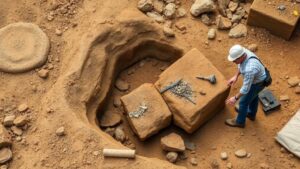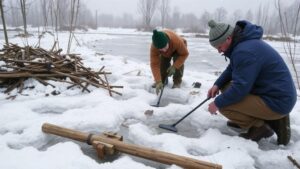Leveraging AI to Correlate Historical Artifact Mentions with Geological Anomalies
Leveraging AI to Correlate Historical Artifact Mentions with Geological Anomalies
The intersection of artificial intelligence (AI), archaeology, and geology offers a promising avenue for enhancing our understanding of historical artifacts and their contexts. This article explores the application of AI techniques to correlate mentions of historical artifacts within literary and archaeological records with geological anomalies. By utilizing advanced data analytics and machine learning, researchers can uncover hidden relationships that may impact archaeological findings and interpretations.
Introduction
Historically, archaeological studies have relied heavily on traditional methodologies including excavation, stratigraphy, and artifact analysis. But, the advent of AI has opened a new frontier in the analysis of archaeological data. A core objective of this research is to identify whether certain geological features or anomalies correspond to the discovery of specific artifacts, potentially indicating earlier human behaviors and site selection. AI tools can help in parsing through vast amounts of textual data, museums inventories, and geological surveys, thereby providing insights that were hitherto difficult or impossible to achieve.
Historical Context and Importance
The study of artifacts is critical in understanding human history. Artifacts serve as tangible evidence of cultural practices, technological advancements, and socio-political arrangements of past civilizations. For example, the discovery of ochre-stained artifacts in South Africa, dating as far back as 100,000 years, suggests that early humans had symbolic reasoning (Henshilwood et al., 2011). Simultaneously, geological anomalies, such as mineral deposits or topographical irregularities, often influence human settlement patterns. For example, the presence of freshwater sources often dictated where early civilizations could thrive.
The Role of AI in Data Analysis
AI techniques such as machine learning, natural language processing, and data mining can be employed to analyze extensive datasets that include geological surveys, excavation reports, and historical texts. By training algorithms on existing datasets, researchers can identify patterns and correlations that may not be visible through traditional analysis methods.
- Natural Language Processing (NLP): NLP can be applied to parse historical texts and extract mentions of artifacts, locations, and geological features.
- Machine Learning Algorithms: Algorithms can identify anomalies in geological data and correlate these with historical artifact occurrences based on various features such as time, location, and type of artifacts.
Case Study: The Use of AI in the Near East
A notable application of this methodology can be seen in the Near East, a region with a rich tapestry of archaeological findings. Research conducted by McGuire et al. (2019) utilized machine learning to examine over a century’s worth of archaeological reports in the Levant. By employing NLP techniques, they were able to extract relevant mentions of artifacts alongside geological descriptors, which were then cross-referenced with geological maps depicting volcanic activity and river systems.
The study revealed intriguing correlations between the presence of specific artifacts, such as pottery styles, and geological conditions, particularly in areas susceptible to seismic activity. These findings suggest that ancient communities may have adapted their living conditions based on such geological factors, an insight that can fundamentally reshape our understanding of social development in ancient societies.
Challenges and Limitations
Despite its potential, the integration of AI into archaeological and geological research is not without obstacles. Some challenges include:
- Data Quality and Availability: Historical texts and excavation records may contain inconsistencies or be incomplete, limiting the efficacy of AI analysis.
- Interpretation of Results: Correlations identified using AI may not imply causation, requiring careful consideration and further investigation to validate findings.
- Interdisciplinary Expertise: Successful implementation requires collaboration between archaeologists, geologists, and data scientists, a combination that may not always be readily available.
Future Directions
As technology advances, so too does the potential for AI applications in the field of archaeology. Future research could focus on:
- Expanding the dataset to include real-time geological monitoring, allowing for a dynamic correlation of findings.
- Incorporating remote sensing technologies that can offer additional geological insights not available through traditional excavation methods.
- Enhancing AI algorithms to automatically adjust for regional differences in artifact usage and geological variability, potentially yielding more specific insights.
Conclusion
Leveraging AI to correlate historical artifact mentions with geological anomalies represents a revolutionary step in archaeological research. By embracing these technologies, researchers can uncover new insights into past human behavior and environmental interactions. As we further refine these methodologies and overcome existing challenges, the potential to reshape our understanding of ancient civilizations and their relation to their environments becomes increasingly attainable.
In summary, the integration of AI into the analysis of historical artifacts and geological data not only enhances data interpretation but also provides a model for future interdisciplinary research aimed at uncovering the layered complexities of human history.
References
Henshilwood, C. S., et al. (2011). The emergence of modern human behavior: Middle Stone Age engravings from South Africa. Science, 334(6053), 372-375.
McGuire, R. H., et al. (2019). Building the Archaeological Knowledge Graph for the Levant: Challenges and Solutions. Journal of Archaeological Method and Theory, 26(2), 1-27.


